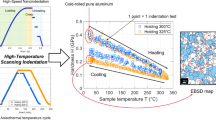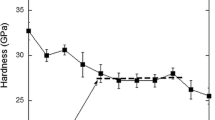Abstract
Utilizing indentation techniques coupled with atomic-force microscopy (AFM) and orientation-imaging microscopy (OIM), it is possible to identify both out-of-plane deformation and slip-band formation around nanoindentations. These effects are due to both strain hardening and cross slip. The effects of hydrogen on body-centered-cubic and face-centered-cubic alloys were tested using nano- and microindentation and show a distinctive change in deformation morphology. Localized slip steps on the surface were examined using OIM and AFM. The frequency of slip steps (number of planes between each step) is not significantly influenced by hydrogen concentration, but the overall height of each step is reduced in the presence of hydrogen.
Similar content being viewed by others
References
J.P. Hirth, Met. Trans., 11A (1980), p. 861.
R.A. Oriani, Corrosion, 43 (1987), p. 390.
P.J. Ferreira, I.M. Robertson, and H.K. Birnbaum, Acta Mater., 47 (1999), p. 2991.
Y. Katz, N. Tymiak, and W.W. Gerberich, Eng. Fracture Mech., 68 (2001), p. 619.
D.S. Dugdale, J. Mech. Physics Solids, 2 (1954), p. 265.
D.F. Bahr and W.W. Gerberich, Met. Trans., 27A (1996), p. 3793.
A.F. Bower, et al., Proc. Royal Soc., 441A (1993), p. 97.
W. Zielinski, et al., Phil. Mag. A, 41 (1993), p. 2855.
T.F. Page, W.C. Oliver, and C.J. McHargue, J. Mater. Res., 7 (1992), p. 450.
K. Jatavallabhula and W.W. Gerberich, Fatigue Eng. Mater. Structures, 4 (1981), p. 173.
Q. Yang, and J.L. Luo, Mater. Sci. Eng. A, A288 (2000), p. 75.
M. Pang and D.F. Bahr, J. Mater. Res., 16 (2001), p. 2634.
D.F. Bahr, D.E. Kramer, and W.W. Gerberich, Acta Mater., 46 (1998), p. 3605.
S.A. Syed Asif and J.B. Pethica, Phil. Mag. A 76 (1997), p. 1105.
A.B. Mann and J.B. Pethica, Appl. Phys. Lett., 69 (1996), p. 907.
W.C. Oliver and G.M. Pharr, J. Mater. Res., 7 (1992), p. 1564.
W.W. Gerberich et al., Hydrogen in Metals, ed. I.M. Bernstein and A.W. Thompson. (Warrendale, PA: TMS, 1980) pp. 731–744.
K.L. Johnson, Contact Mechanics, (Cambridge, UK: Cambridge University Press, 1985), pp. 154–183.
Author information
Authors and Affiliations
Additional information
For more information, contact David F. Bahr at Washington State University, Mechanical and Materials Engineering, PO Box 642920, Pullman, WA, 99164-2920 (509) 335-8523; fax (509) 335-4662; e-mail bahr@mme.wsu.edu
Rights and permissions
About this article
Cite this article
Bahr, D., Field, D., Nibur, K. et al. Hydrogen and deformation: Nano- and microindentation studies. JOM 55, 47–50 (2003). https://doi.org/10.1007/s11837-003-0226-4
Issue Date:
DOI: https://doi.org/10.1007/s11837-003-0226-4




